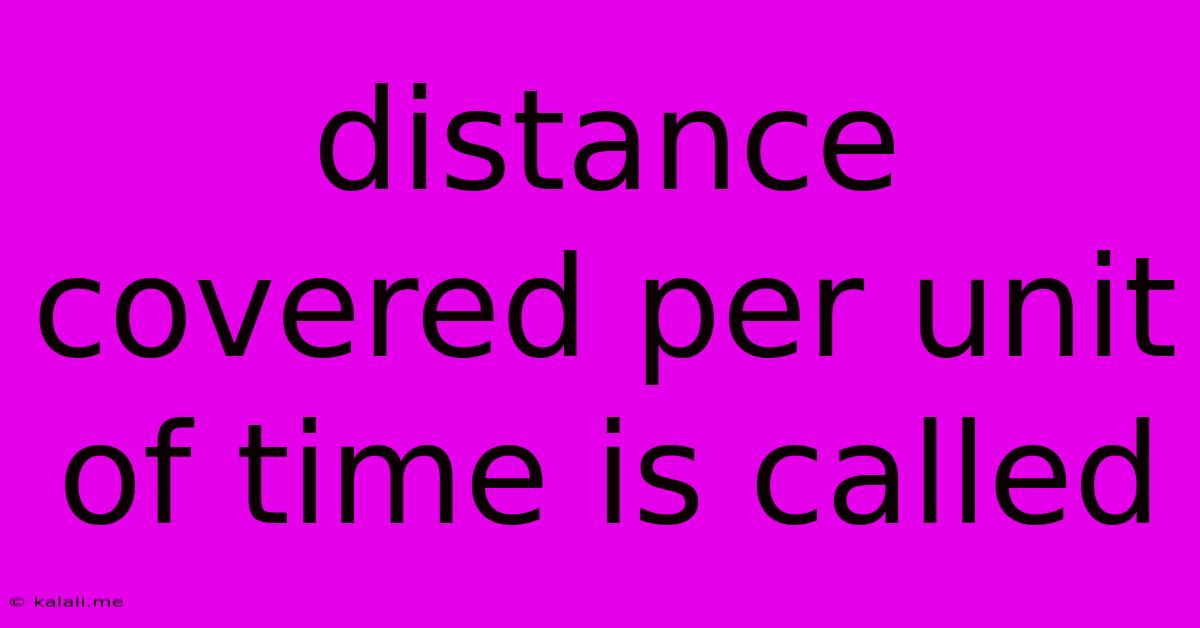Distance Covered Per Unit Of Time Is Called
Kalali
Jun 14, 2025 · 2 min read

Table of Contents
Distance Covered Per Unit of Time is Called: Speed and its Variations
The fundamental concept of distance covered per unit of time is a cornerstone of physics and everyday life. This article will delve into what this crucial measurement is called, exploring its various forms and applications. Understanding speed, velocity, and other related concepts is vital in numerous fields, from simple navigation to complex scientific calculations.
What is it called? Speed!
Simply put, the distance covered per unit of time is called speed. Speed is a scalar quantity, meaning it only has magnitude (size) and no direction. If you travel 100 kilometers in 2 hours, your average speed is 50 kilometers per hour (km/h). This is a simple calculation: Distance / Time = Speed.
Understanding the Nuances: Velocity vs. Speed
While speed focuses solely on the magnitude of movement, velocity incorporates both magnitude and direction. Velocity is a vector quantity. This means that if you travel 100 kilometers east in 2 hours, your average velocity is 50 km/h east. The direction is crucial in defining velocity.
Imagine a runner completing a lap on a track. Their final speed might be zero (as they return to their starting point), but their velocity will likely be non-zero because of their change in direction. This is because velocity is determined by displacement (the change in position from the start to the end point), which is not always equal to the total distance covered.
Beyond Average Speed: Instantaneous Speed
Average speed considers the total distance covered over a period. However, often we're interested in the speed at a specific moment. This is called instantaneous speed. Think of a car's speedometer – it displays instantaneous speed. Calculating instantaneous speed requires more advanced techniques, often involving calculus.
Other Related Concepts:
- Rate: Speed is a type of rate, specifically the rate of change of distance with respect to time. Many other rates exist, such as the rate of fuel consumption or the rate of data transfer.
- Acceleration: Acceleration describes the rate of change of velocity over time. This incorporates both changes in speed and changes in direction. A car accelerating from 0 to 60 km/h in 10 seconds has a positive acceleration.
Practical Applications of Speed and Velocity:
The concepts of speed and velocity are fundamental to numerous applications, including:
- Navigation: Calculating travel times and routes.
- Traffic management: Monitoring vehicle speeds and optimizing traffic flow.
- Sports analysis: Measuring athlete performance.
- Physics: Understanding projectile motion, orbital mechanics, and many other phenomena.
- Engineering: Designing vehicles, aircraft, and other moving systems.
Understanding the difference between speed and velocity, as well as the concept of instantaneous speed, is crucial for accurate descriptions of motion. Whether it's calculating travel time for a road trip or understanding the complexities of orbital mechanics, the distance covered per unit of time—speed—provides a fundamental framework for comprehending the world around us.
Latest Posts
Latest Posts
-
Laplace Transform Of Unit Ramp Function
Jun 15, 2025
-
A Strip Of Land Surrounded By Water On Three Sides
Jun 15, 2025
-
What Is The Roman Numeral For 400
Jun 15, 2025
-
Drop Forging Is Used To Produce
Jun 15, 2025
-
How Many Meters In A Decameter
Jun 15, 2025
Related Post
Thank you for visiting our website which covers about Distance Covered Per Unit Of Time Is Called . We hope the information provided has been useful to you. Feel free to contact us if you have any questions or need further assistance. See you next time and don't miss to bookmark.